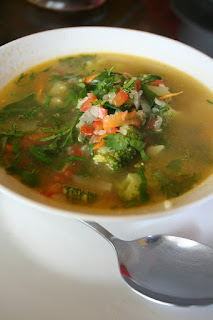In town, we took a chance on a place offering a vegetarian menu from its upstairs window. The restaurant, Aguaymanto, was accessed via one of the many courtyards covered in artisanal goods. The name of the restaurant translates as physalis or, as I have seen it described, "Sacred Valley gooseberry".
 |
| Healthy start |
The menu started with a broccoli soup that hid a hint of ginger, and hinted at the Asian fusion flavours favoured by the kitchen. Fittingly, K's main course was arroz chaufa (Chinese fried rice), while my falafel burger fell into neither Peruvian nor Chinese camps, but was tasty nonetheless.
 |
| Undone by greed |
After lunch, we took a chance on a couple of museums reported by many to be slightly disappointing, but whose entrance was covered by our boleto turístico.
The museum of popular art turned out to be a trove of colourful figures and fascinating sculptures, many of which displayed characteristics of syncretism - the mix of Andean traditions with imported Catholic iconography.
 |
| Sculptured scenes |
With the arrival of the Spanish, Inca festivities such as Inti Raymi were replaced with Catholic celebrations - a procession of saints' effigies at Corpus Christi took the place of an annual parade of ancestral mummies. Even ancient traditions took on Christian elements, such as the Q'oyllur Riti pilgrimage to the sacred mountains, thought to be gods or divine spirits (apus), but which in the 18th century gained new symbolism. A boy appeared to a poor shepherd, bringing bread each day and wearing rags of material similar to that used to dress images of saints in the nearby monetary. However, when the bishop visited to discover the identity of the boy, he disappeared, leaving a cross and an image of Christ on a rock. The pilgrimage of the "Lord of the Star Snow" mixes pre-Inca beliefs with such modern miracles.
 |
| Q'oyllur Riti pilgrimage |
Even such iconic images as the Nativity (nacimiento) have an Incan slant, with Andean musicians serenading the baby Jesus with panpipes, surrounded by llamas and condors, while the Kings bring offerings of corn. Corn also makes an appearance in images of the Last Supper (última cena), where accompanies cuy (guinea pig) on the apostles' plates.
 |
| A very native Natuvity |
After the popular art, the museum of contemporary art was a bit of a disappointment, with only a couple of rooms of stone sculptures, such as the iconic otorongo (jaguar) wrestling an amaru (serpent) while a condor claws at its back. These three animals are considered 'magical' in the Andean cosmovision.
After this cultural nourishment, I insisted that we stop at La Bodega 138. Although ostensibly an Italian restaurant, with what look to be excellent wood-fired pizzas, I was interested in their comprehensive range of Peruvian craft beer.
 |
| #Craft |
From a list covering principally Lima-based breweries - Cumbres, Maddock, Barbarian, Nuevo Mundo - as well as relative locals Cervecería del Valle Sagrado, from Cusco's Sacred Valley. I opted for a pair from Cumbres' Gourmet label: an IPA given a distinctive purple-red colour from the maíz morada, but which delivered on hoppiness in a way that no other South American beer has, and "Café", a barley wine brewed with coffee, which tasted more like a porter, lacking the syrupy booziness of its style.
 |
| Purple corn IPA |
After the libations, it was on to the Centro Qosqo de Arte Nativo for some folk and traditional dance from the region. A selection of regional dances - each necessitating a new, more elaborate costume - were performed with style, energy, and vigour from both the women and men.
 |
| Dancing folk |
The purposes of the dances were understandable: a celebration of the arrival of rain, a courting dance, and a bizarre war dance in which a comic relief character - very possibly representing the Europeans with his silly pink face and pronounced nose - interrupts the performance with his pranking.






No comments:
Post a Comment